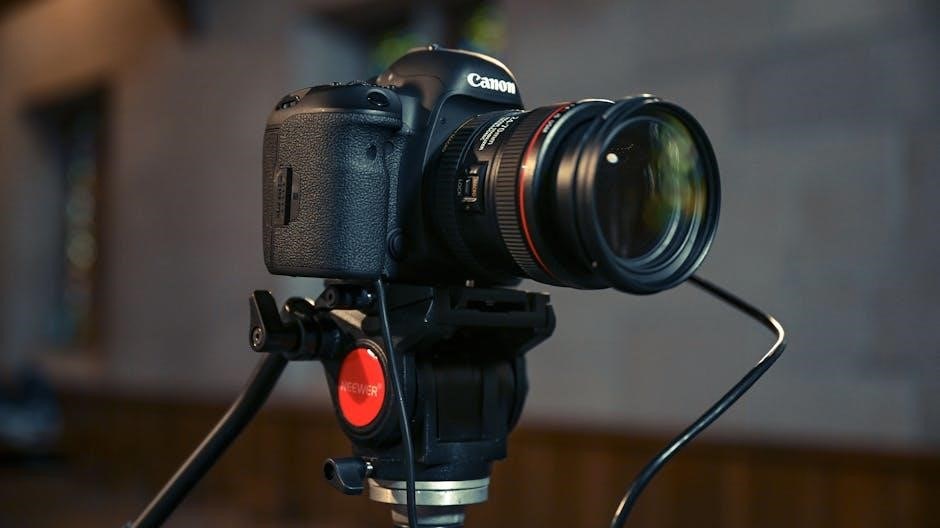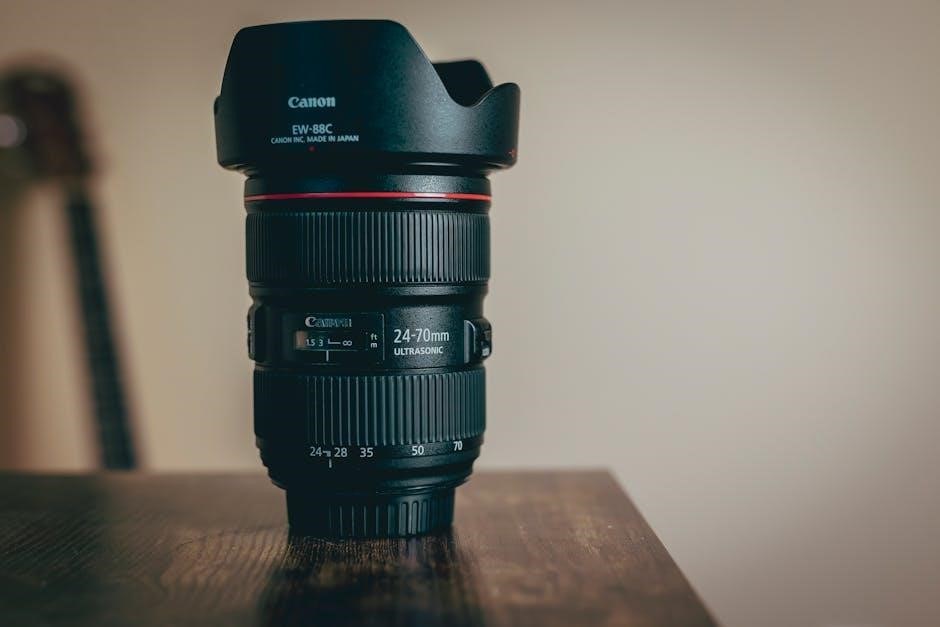The Canon PowerShot SX60 HS is a high-performance superzoom camera offering a 65x optical zoom, 16.1MP CMOS sensor, and advanced video capabilities, ideal for enthusiasts seeking DSLR-like control in a compact design. This guide provides a comprehensive overview of its features, operation, and customization options to help users maximize its potential.
1.1 Overview of the Camera
The Canon PowerShot SX60 HS is a bridge camera featuring a 65x optical zoom lens, 16.1MP CMOS sensor, and 1080/60p HD video recording. It offers Wi-Fi and NFC connectivity, making it versatile for both stills and video. Designed for enthusiasts, it combines DSLR-like controls with a compact form, making it an ideal alternative to carrying multiple lenses. Its ergonomic design and advanced features cater to photographers seeking precision and creativity.
1.2 Importance of the Manual
The Canon PowerShot SX60 HS manual is essential for unlocking the camera’s full potential, especially for those transitioning from DSLRs. It provides detailed guidance on advanced features like 65x zoom, manual video settings, and Wi-Fi connectivity. Users have expressed difficulty finding specific settings, highlighting the manual’s role in mastering the camera’s capabilities. This guide ensures a smooth and efficient experience, helping photographers of all levels optimize their workflow and creativity.

Key Features of the Canon PowerShot SX60 HS
The Canon PowerShot SX60 HS stands out with its 65x optical zoom, 16.1MP CMOS sensor, and 1080/60p HD video recording. It also features Wi-Fi and NFC connectivity for seamless sharing and remote control.
2.1 65x Optical Zoom Lens
The Canon PowerShot SX60 HS features a remarkable 65x optical zoom lens, covering an impressive 21-1365mm equivalent focal range. This lens delivers exceptional versatility, capturing everything from wide-angle landscapes to distant wildlife or celestial objects with precision. The vast zoom range makes it ideal for photographers seeking flexibility without the need for multiple lenses. Image stabilization ensures sharp results even at maximum zoom, enhancing overall shooting versatility and convenience.
2.2 16.1MP CMOS Sensor
The Canon PowerShot SX60 HS is equipped with a 16.1MP CMOS sensor, delivering high-resolution images with excellent detail and color accuracy. Paired with Canon’s DIGIC 6 image processor, it ensures superior image quality, even in low-light conditions. The sensor’s back-illuminated design enhances light capture, reducing noise and improving dynamic range. This combination allows for crisp, vibrant photos and smooth 1080/60p HD video recording, making it ideal for both stills and video enthusiasts.
2.3 1080/60p HD Video Recording
The Canon PowerShot SX60 HS captures stunning 1080/60p Full HD videos, delivering smooth motion and exceptional detail. With frame rates up to 60fps, it excels in recording dynamic scenes and fast-moving subjects. The camera supports MP4 format for easy sharing and editing. Built-in stereo microphones ensure high-quality audio, while image stabilization minimizes camera shake during recording, resulting in professional-looking videos with crisp clarity and vibrant colors.
2.4 Wi-Fi and NFC Connectivity
The Canon PowerShot SX60 HS features built-in Wi-Fi and NFC, enabling seamless connectivity. Users can wirelessly transfer images to smartphones, tablets, or computers and remotely control the camera via the Canon Camera Connect app. NFC simplifies pairing with compatible Android devices, allowing quick and easy file sharing. This functionality enhances workflow and makes it convenient to share moments instantly, perfect for social media and backup purposes.

Design and Ergonomics
The Canon PowerShot SX60 HS features an ergonomic design with a comfortable grip, ensuring stability and ease of use during extended shooting sessions or handheld photography.
3.1 Exterior Design and Build Quality
The Canon PowerShot SX60 HS boasts a sturdy, polycarbonate exterior with a textured grip for secure handling. Its compact yet robust design ensures durability, while the intuitive control layout enhances usability. The lens barrel is reinforced for stability, and the overall build quality reflects Canon’s attention to detail, making it both reliable and comfortable for extended use;
3.2 Removal of the Timer Button
The Canon PowerShot SX60 HS no longer features a dedicated timer button, streamlining its design. Users must now access the self-timer through the menu system under shooting settings. This change reduces physical controls but maintains functionality. The timer can be set to 2 or 10 seconds, or turned off, ensuring flexibility. This adjustment aligns with modern camera design trends, emphasizing menu-based customization for enhanced user experience.
3.4 Comparison with DSLR Cameras
The Canon PowerShot SX60 HS differs from DSLR cameras in size, weight, and functionality. While DSLRs offer interchangeable lenses and superior image quality, the SX60 HS provides a compact, portable design with a built-in 65x zoom lens. It caters to casual photographers seeking convenience without compromising on advanced features like manual controls and HD video recording, making it a versatile alternative to bulkier DSLR systems.

Manual Settings and Customization
The Canon PowerShot SX60 HS offers extensive manual controls, allowing users to adjust aperture, shutter speed, and ISO for precise creativity. Customizable buttons enable personalized shooting experiences, enhancing workflow efficiency and adaptability to various photography scenarios. These features provide amateur and advanced photographers with a flexible tool for achieving desired image results effectively.
4.1 Accessing Manual Settings
Accessing manual settings on the Canon PowerShot SX60 HS is straightforward. Use the mode dial to select Manual (M) mode, then adjust aperture, shutter speed, and ISO using the control dial and rear dial. The menu system provides additional customization options, allowing users to fine-tune settings for optimal control over their photography. This ensures a seamless and intuitive manual shooting experience.
4.2 Maximum and Minimum Manual Settings for Video
For video, the Canon PowerShot SX60 HS allows manual control with aperture ranging from f/3.4 to f/8.0 and shutter speed from 1/8 to 1/2000 seconds. ISO can be set between 100 and 6400. These settings enable precise control over exposure, depth of field, and motion blur, helping users achieve their desired visual effects in video recording. This flexibility enhances creative possibilities for videographers.
4.3 Customizing Controls
The Canon PowerShot SX60 HS allows users to customize controls for personalized shooting experiences. The Shortcut button can be assigned to frequently used functions, while the Control Dial’s direction can be adjusted. Users can also assign functions to the Rear Control Dial, enabling quick access to settings like aperture, shutter speed, or ISO. This customization enhances efficiency and streamlines the shooting process.
Video Features and Capabilities
The Canon PowerShot SX60 HS offers 1080/60p HD video, a 65x zoom for detailed shots, and image stabilization for smooth footage. It also supports external microphones for enhanced audio.
5.1 Maximum and Minimum Video Settings
The Canon PowerShot SX60 HS supports video recording at resolutions up to 1080p at 60fps for smooth motion. Minimum settings include 720p at 30fps, ideal for smaller file sizes. The camera allows manual control over exposure and focus during recording, ensuring flexibility. Built-in compression optimizes storage, though higher settings may require faster memory cards for uninterrupted capture.
5.2 Manual Video Mode
Manual Video Mode on the Canon SX60 HS offers advanced control over video settings, allowing adjustments to aperture, shutter speed, and ISO. Users can optimize exposure and focus for creative results. Manual focus ensures precise subject sharpness, while exposure compensation fine-tunes brightness. This mode is ideal for experienced videographers seeking full control, though it requires a good understanding of manual settings to achieve optimal results.

Shooting Modes and Scenes
The Canon SX60 HS offers multiple shooting modes, including Auto, Program Auto, Aperture Priority, Shutter Priority, Manual, and Scene Modes, catering to various photography scenarios. Scene Modes like Portrait, Landscape, and Sports optimize settings for specific subjects, while Superzoom Mode enhances telephoto capabilities, making it versatile for diverse shooting conditions and user preferences.
6.1 Auto Mode
In Auto Mode, the Canon SX60 HS automatically adjusts settings like exposure, ISO, and focus for quick, hassle-free shooting. The camera analyzes the scene and optimizes settings for best results, making it ideal for beginners or casual photography. Scene detection automatically adjusts for conditions like landscapes, portraits, or low light, ensuring balanced and vibrant images without manual adjustments.
6.2 Program Auto (P)
Program Auto (P) mode offers a balance between convenience and control. The camera automatically sets aperture and shutter speed but allows adjustments to settings like ISO, white balance, and flash. This mode is ideal for photographers who want to make minor tweaks without full manual control, offering flexibility while maintaining ease of use for capturing high-quality images in various lighting conditions.
6.3 Aperture Priority (Av)
In Aperture Priority mode, you set the aperture value, and the camera automatically adjusts the shutter speed for proper exposure. This mode is ideal for controlling depth of field, allowing you to blur backgrounds or keep landscapes sharp. Adjust the aperture using the control dial, with the camera handling the rest to ensure creative flexibility and precise focus control in various lighting scenarios.
6.4 Shutter Priority (Tv)
In Shutter Priority mode, you set the shutter speed, and the camera adjusts the aperture. This mode is great for capturing motion, allowing you to freeze fast-moving subjects or create blur. Useful for sports and action photography, it offers control over image motion while maintaining proper exposure.
6.5 Manual (M) Mode
In Manual (M) Mode, you have full control over aperture and shutter speed, allowing precise adjustments for creative photography. Access manual controls via the mode dial or menu. Adjust settings using the control ring or rear dial. This mode is ideal for advanced users seeking exact control over exposure. Experiment with different combinations to achieve desired effects, ensuring optimal results in various lighting conditions.
6.6 Scene Modes
Scene Modes optimize camera settings for specific situations like portraits, landscapes, or sports. Access them via the mode dial or menu. Each mode adjusts aperture, shutter speed, and ISO for ideal results. Popular options include Portrait, Landscape, Sports, and Low Light modes. These modes simplify photography, ensuring professional-looking images without manual adjustments. They enhance image quality by tailoring settings to the scene’s demands, making them versatile for various shooting conditions.
6.7 Superzoom Mode
Superzoom Mode extends the camera’s zoom range beyond its optical limit, offering a digital boost for extreme close-ups. It captures detailed images at impressive distances, ideal for wildlife or distant subjects. While it may reduce image quality slightly, it provides unmatched versatility. Use it wisely, as overuse can soften details. A tripod is recommended for stability in this mode.

Image Quality and Performance
The Canon SX60 HS delivers crisp, vibrant images thanks to its 16.1MP CMOS sensor and DIGIC 6 processor, ensuring excellent detail and color accuracy even in challenging lighting conditions.
7.1 Sensor and Image Processing
The Canon SX60 HS features a 16.1MP CMOS sensor, capturing high-resolution images with excellent detail and color reproduction. Paired with the DIGIC 6 image processor, it ensures fast processing speeds and reduced noise, even in low-light conditions. This combination enhances overall image quality, providing sharp and vibrant results across various shooting scenarios, making it ideal for both still photography and video recording purposes.
7.2 ISO Range and Noise Performance
The Canon SX60 HS offers an ISO range of 100 to 3200, allowing flexibility in various lighting conditions. At lower ISOs, images remain sharp with minimal noise. However, noise becomes more apparent at higher ISOs, particularly above 800. The DIGIC 6 processor helps mitigate noise, ensuring decent image quality even in low-light scenarios. For optimal results, keeping ISO below 800 is recommended to maintain clarity and detail in your photos.
7.3 Autofocus Speed and Accuracy
The Canon SX60 HS features a fast and accurate autofocus system, making it ideal for capturing sharp images of moving subjects. Using advanced TTL autofocus, the camera quickly locks onto targets, even in challenging lighting conditions. The DIGIC 6 image processor enhances AF performance, ensuring precise focus acquisition. However, in low-light scenarios, autofocus speed may slow slightly, though accuracy remains reliable for most shooting situations.

Compatible Accessories
The Canon SX60 HS supports a variety of accessories to enhance functionality, including lenses, tripods, memory cards, and other peripherals designed to optimize your photography experience.
8.1 Lenses and Filters
The Canon SX60 HS is compatible with various lenses and filters, enhancing its versatility. Tele converters extend the zoom range, while close-up lenses enable macro photography. Neutral density filters control light, and polarizing filters reduce glare. These accessories are designed to fit the camera’s lens system, ensuring optimal performance and image quality without compromising functionality.
8.2 Tripods and Stabilization
A tripod is essential for stabilizing the Canon SX60 HS, especially when using its powerful zoom. The camera’s built-in image stabilization reduces shake, but a tripod ensures sharp images in low light or at full zoom. Invest in a sturdy tripod to minimize movement and blur, allowing for clearer photos and smoother video recording, even in challenging conditions.
8.3 Memory Cards and Storage
The Canon SX60 HS supports SD, SDHC, and SDXC memory cards, ensuring ample storage for high-resolution photos and videos. For optimal performance, use a high-speed Class 10 card with at least 32GB capacity. Regularly formatting your memory card in the camera prevents errors and ensures compatibility. Always carry spare cards to avoid running out of storage during shoots.

Wi-Fi and NFC Connectivity
The Canon SX60 HS features built-in Wi-Fi and NFC, enabling seamless image transfers, remote camera control, and quick device pairing for enhanced wireless connectivity and convenience.
9.1 Setting Up Wi-Fi
To set up Wi-Fi on the Canon SX60 HS, access the menu, select Wi-Fi settings, and choose your connection method—direct connection or via a router. Ensure the camera’s Wi-Fi is enabled, then select the network name (SSID) and enter the password. The camera can also connect to compatible devices like smartphones or computers for easy image transfer and remote control. Refer to the manual for detailed troubleshooting tips.
9.2 Using NFC for Quick Transfers
Enable NFC on the Canon SX60 HS by accessing the Wi-Fi settings menu. Locate the NFC antenna on the camera’s side. Bring an NFC-enabled device close to the antenna to establish a connection. Once paired, images can be transferred wirelessly. This feature allows quick backups or sharing without cables, streamlining your workflow and enhancing convenience for photo management.
9.3 Remote Shooting and Control
Enable Wi-Fi on the Canon SX60 HS and connect to a smartphone using the Canon Camera Connect app. This allows remote shooting, enabling control over focus, zoom, and video recording. Adjust settings like aperture, shutter speed, and ISO directly from your device. Live preview ensures precise framing and enhances convenience for capturing photos and videos without physical camera operation.

Troubleshooting Common Issues
The Canon SX60 HS may encounter common issues like lens obstruction or Wi-Fi disconnections. Restarting the camera or resetting settings often resolves these issues quickly.
10.1 Common Errors and Solutions
The Canon SX60 HS may display errors like “Lens Obstruction” or “Wi-Fi Connection Failed.” For lens issues, clean the lens gently with a microfiber cloth. Wi-Fi problems often resolve by restarting the camera or updating firmware. Battery drain can be addressed by adjusting power-saving settings. SD card errors may require formatting the card in the camera. For autofocus malfunctions, switch to manual focus or reset the camera settings.
10.2 Resetting the Camera
To reset the Canon SX60 HS, navigate to the menu, select the wrench icon, and choose “Reset Settings.” This restores default settings while preserving customizations. For a full factory reset, press and hold the MENU and INFO buttons while turning the camera on. This clears all custom settings and returns the camera to its original state. Always save important settings before resetting.

Tips for Getting the Most Out of Your SX60 HS
Utilize the 65x zoom for distant subjects, stabilize with a tripod, experiment with manual modes, and leverage Wi-Fi for seamless image transfers to enhance your photography experience.
11.1 Mastering the Zoom Range
The Canon SX60 HS boasts a remarkable 65x optical zoom, enabling capture of distant subjects with precision. To master this feature, use image stabilization for sharp results, especially at extreme zoom levels. Experiment with Superzoom mode for extended reach, though it may slightly compromise image quality. Practice panning and framing to maintain focus on moving subjects, ensuring dynamic and impactful compositions.
11.2 Optimizing Image Stabilization
Maximize the Canon SX60 HS’s image stabilization by using the lens-based system effectively. Enable IS in the menu for handheld shooting and when using telephoto zoom. For video, switch to Dynamic IS to reduce camera shake. Use a tripod for maximum stability, especially in low light. Disable IS only when mounted on a tripod to prevent overcorrection, ensuring sharper images and smoother footage in all conditions.
11.3 Best Practices for Video Recording
For optimal video recording on the Canon SX60 HS, use the highest resolution (1080/60p) for crisp footage. Enable Dynamic IS for smoother handheld videos. Use a tripod for stability, especially with the 65x zoom. Focus manually for precise control over moving subjects. Record in MP4 format for smaller files. Use external microphones for better audio. Format memory cards regularly and ensure ample storage. Keep the camera updated for enhanced performance.
The Canon SX60 HS offers exceptional versatility and advanced features, making it ideal for photographers and videographers. This manual provides comprehensive guidance to maximize its potential and enhance your creative journey.
12.1 Final Thoughts on the Canon SX60 HS
The Canon SX60 HS is a powerful and versatile camera, excelling in zoom capabilities and video recording. Its 65x optical zoom and image stabilization make it ideal for wildlife and distant subjects. While it may not match DSLR image quality, its portability and features like Wi-Fi and NFC make it a great choice for enthusiasts. Minor drawbacks like LCD resolution and handling at max zoom are overshadowed by its overall performance, making it a solid option for creative photography and videography needs.
12.2 Recommended Resources for Further Learning
For deeper mastery of the Canon SX60 HS, explore official Canon resources, including the Canon website and support pages. Additionally, third-party photography websites, YouTube tutorials, and forums like DPReview or Flickr groups offer valuable insights. Consider purchasing dedicated photography books or joining Facebook groups focused on the SX60 HS for shared tips and experiences. Check the Canon store for workshops or live webinars.